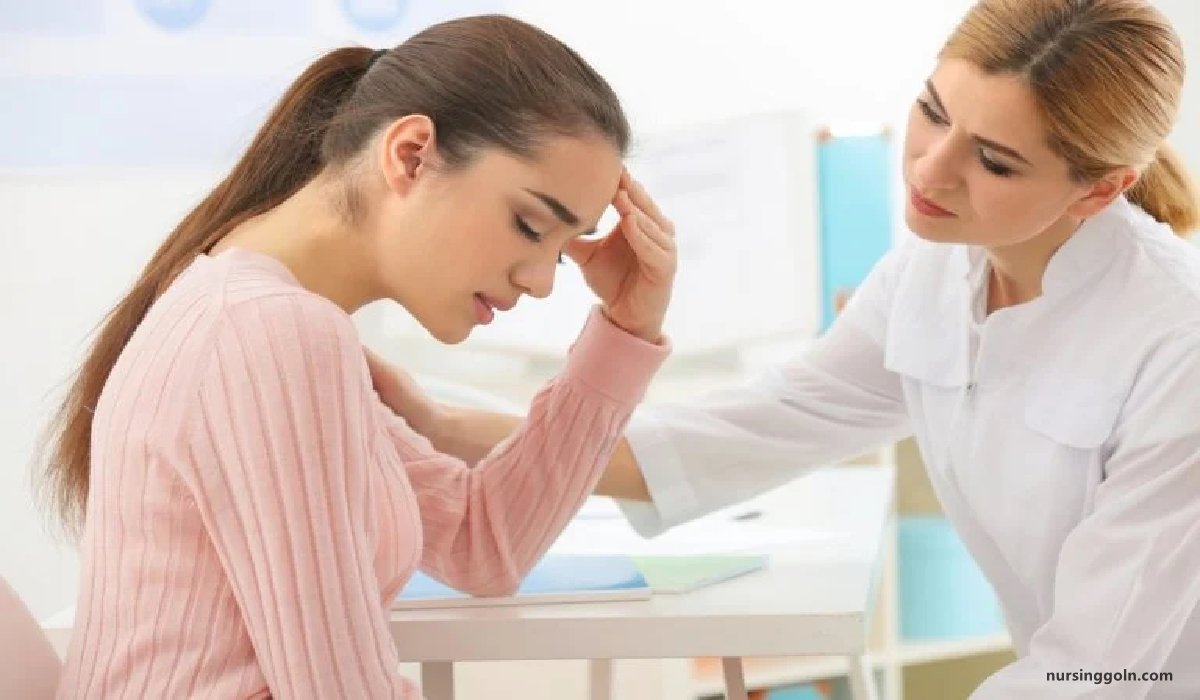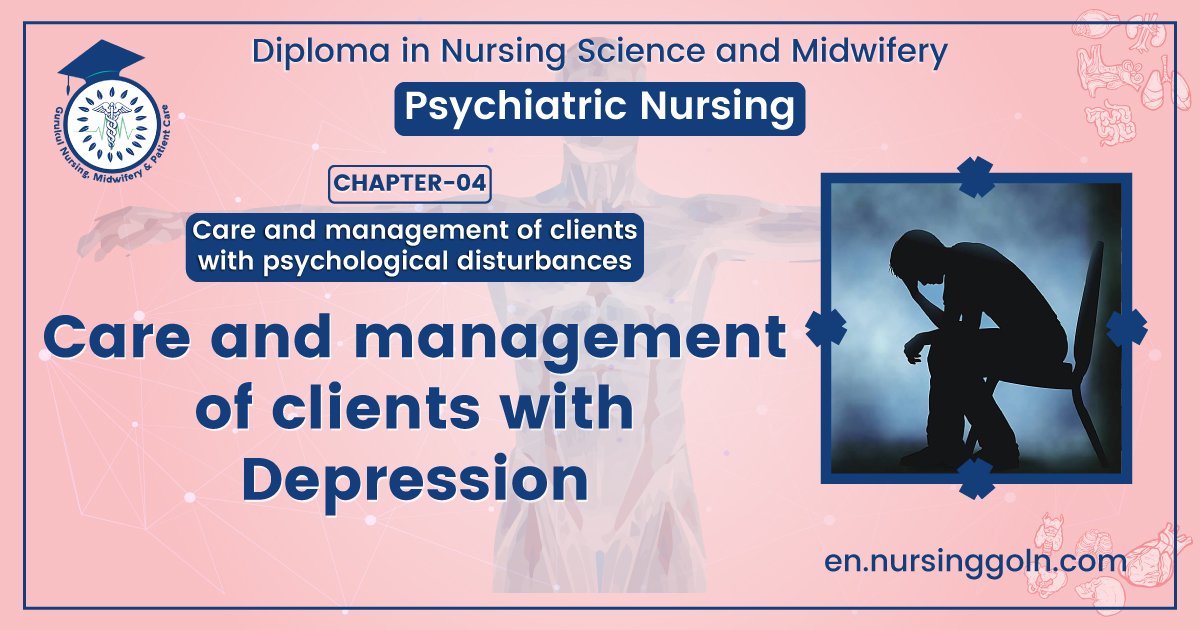Care and management of clients with depression– This book covers the entire syllabus of “Psychiatric Nursing” prescribed by the Universities of Bangladesh- for Basic and diploma nursing students. We tried to accommodate the latest information and topics. This book is an examination-friendly setup according to the teachers’ lectures and examination questions.
At the end of the book previous university questions are given. We hope in touch with the book students’ knowledge will be upgraded and flourish. The unique way of presentation may make your reading of the book a pleasurable experience.

Care and management of clients with depression
A mental or physical condition characterised by insomnia, anorexia, irritability, emotionalization, impaired concentration and suicidal tendency is termed as depression.
Depressive illness:
Depression is an affective disorder which is characterized by feelings of overwhelming sadness or lack of enjoyment, sometimes with anxiety and irritability with change in eating habit, sleep and sexual function.
[Ref: Clinical Consult to Psychiatric Nursing/1/143)
Causes of the depression
1. Recent traumatic events (job loss etc.)
2. Stressful situations (family disagreements, poverty)
3. Serious physical illness
4. Divorce, end of relationship
5. Recent death of a friend or a close relative
6. Problems during childhood (abuse, early loss of a parent)
7. Personal weakness, nervousness
8. An illness of the brain
9. Recent pregnancy
10. Menopause
11. Having parents or grandparents suffering from depression
12. Post-partum
13. Certain medications
14. Conflict
15. Death
16. Genetical issues
17. Drastic events in life
18. Substance abuse
19. Accidents or health issues
Classification of depression:
a. Group I:
i. Reactive depression (due to exogenous adverse effect)
ii. Endogenous depression.
b . Group II: According to aetiology:
i. Primary depression.- no cause
ii. Secondary depression.- to chronic disease, malignancy,
c. Group III:
i. Seniledepression.
ii. Involutional depression.
d. Group IV: According to severity /ICD-10-:
i. Mild depression.
ii. Moderate depression.
iii. Severe depression. Without psychotic symptoms With psychotic symptoms
e. Group V:
i. Unipolar depression.
ii. Manic depression (Bipolardisorders)
[Ref-Kumar & Clark 1198/7th + Davidson’s/22/243)

Clinical features of depression:
Mild Depression:
1. Rigid,
2. Sensitive to criticism,
3. Fatigue,
4. Flattened of mood,
5. Blunt affect,
6. Dullness, sad, anxious, empty mood,
7. Physical complaints with no organic cause,
8. Blue spells,
9. Lacks confidence in himself,
10. Lack of interest in activities once enjoyed, including sex;
11. Reduced energy.
12. Lowered activity performance,
13. Inadequacy,
14. Exhibits aversion to activities,
15. Spends alone,
16. Finds difficulty in performing ordinary activities,
17. Sleeping disturbances,
18. Anorexia,
19. Feeling of hopelessness/helplessness,
20. Pessimism,
21. Worthlessness,
22. Unreasonable guilt,
23. Self blaming.
24. Low self-esteem
Acute or Severe Depression:
1. Client feels tensed,
2. Unable to relax,
3. Anxious,
4. Low or poor concentration,
5. Lack of attention,
6. Poor memory,
7. Guilty,
8. Inadequacy feelings,
9. Loss of energy,
10. Tired, exhausted,
11. Vague feeling of body aches,
12. Severe headache,
13. GIT manifestations,
14. Restlessness,
15. Irritability,
16. Cannot concentrate for longer period,
17. Diurnal variations (depression is more in early morning and in late evenings).
Depressive Stager
Intensive form in which the client will have-
1. Acute dementia,
2. Mute,
3. Clouded sensorium,
4. Preoccupied mind,
5. Hallucinations,
6. Depersonalization,
7. Derealization,
8. Delusion,
9. Progresses into death.
(Ref: KP Neeraja/1″/Vol-2/392-393/
Central features of depressive disorder;
Depressed mood or
Loss of interest and pleasure, with 4 or more of the following seven symptoms:
✓ Feelings of worthlessness or guilt
✓ Impaired concentration
✓ Loss of energy and fatigue
✓Thoughts of suicide
✓ Loss or increase of appetite and weight
✓Insomnia or excessive sleep and
✓ Retardation or agitation.
(Ref: S Nambi/2/77)
Management of depressive illness:
1. Hospitalization: If the depression is severe and there are suicidal tendencies, it is better to hospitalize the patient for further management.
2. Drug therapy: With the help of antidepressants, depression can be relieved in a few weeks time. The details regarding drug therapy are given in the chapter on drug treatment (Antidepressant drags).
3. Electroconvulsive therapy: It is an effective physical method of treatment in major depression. It is advisable if the depression is severe and with suicidal tendency. ECT is widely used in combination with antidepressant drugs,
4. Psychotherapy: Psychotherapy means understanding the depressed patients and their problems and guiding them positively. It includes reassurance and supportive measures, and encouraging patients to freely communicate with the therapist. The emotional ventilation has dramatic effect in relieving depression. Family therapy, group therapy and cognitive therapy are also indicated in selected cases of depression. The selection of treatment depends on the individual patients.
[Ref: S Nambi/2/801
Treatment of depressive disorder:
1. Monoamino reuptake inhibitors-Amitriptyline 75-300 mg/day
2. Clomipramine 75-80 mg/day
3. Selective serotonin reuptake inhibitors (SSRIs)-
4. Fluoxetine 1G-80 mg/day
5. Sertraline 50-200 mg/day
6. Fluvoxamine 50-300 mglday
7. Dopaminergic antidepressants – Fluvoxamine 50-300 mg day
8. Atypical antidepressants. Amineptine 100-400 mg/day
9. Mono aminooxidase inhibitors (MAO). Isocarboxazid 10-30 mg/day
10. Miscellaneous newer antidepressants. Venlafaxine 150-375 mg/day
11. Bupropion 150-450 mg/day
Electroconvulsive Therapy:
ECT is indicated to have rapid action and remission of symptoms. In major depression cases it will be given as initial treatment and fosters antidepressant action.
Psychotherapeutic Approach:
1. Supportive Psychotherapy
2. Psychoanalysis
3. Group therapy
4. Interpersonal therapy
5. Family therapy
6. Marital therapy
7. Behavior therapy
8. Cognitive Therapy
(Ref: KP Neeraja/1/Vol-2/393-394)

Nursing management of depressive disorder:
1. Promote sleep and food intake-give the prescribed drugs in time and monitor food intake and, if necessary administer IV fluids.
2. Assess if there is any suicidal tendenry. Take safety measures and keep vigil if patient has suicidal ideas. The patient’s safety is a nursing priority.
3. Diminish feelings of loneliness. Build trust by a one-to-one relationship.
4. Improve interaction with the patient.
5. The interaction should focus on the present, not the past or far into the future. Reassure the patient that the present depressed mood state is temporary and that he will be protected and helped. Use a kind, firm and warm attitude. The presence of a rusted individual provides emotional security for the patient.
6. Postpone to your patients decision making and resumption of duties.
7. Provide non-intellectual activities. For example, cleaning and physical exercise provide safe and effective methods for discharging pent-up tension.
8. Encourage expression of emotions, denial, hopelessness, helplessness, guilt, ete. Provide the patient the opportunity to cry out and ventilate his anger.
9. Keep strict records of sleeping patterns. Discourage sleep during the day to promote more restful sleep at night. At night use measures that may promote sleep, such as warm drinks (milk), warm baths, soft music, etc.
10. Limit intake of drinks like coffee, tea and colas. Assist patient in getting to sleep until normal sleep pattern is restored.
11. Indicate that success is possible and not to be hopeless.
12. Health Education
- Regarding the disease: Educate your depressive patients with the following guidelines:
- Depression is far more common than you might think
- Depression can occur without any obvious external cause, due to biochemical imbalance
- Sometimes the process of getting better takes time and one must wait
13. You are not alone; there are many people around you who care about your well-being like your family, your friends and your doctor and his team
14. Regarding drugs
- Take your medicines carefully and regularly. Never take less or more than the
- prescribed dose. Never skip a dose Do not expect miracles. It could be at least two weeks before you feel better
- There may be some side effects due to the antidepressants, like dry mouth,
- constipation, giddiness; do not worry about them Some medicines can make you sleep initially and it is good for you to sleep well.
- Avoid driving or performing any activity which might need a lot of concentration after taking these drugs.
- Avoid taking alcohol when you are on medication. They may interact and produce harm
- Do not stop treatment without the doctor’s advice
15. Advice to family members:
- Educate the family members in the following ways
- Understand that the patient’s problems are due to depression, a disease like any other physical disease and needs active treatment
- Give correct history to the doctor
- Give the medication regularly as prescribed by the doctor
- Give adequate support and encouragement, so that patient may feel, more secure and the recovery will be faster
- Watch for any suicidal ideas or gestures and inform your doctor:
- Accept him as he is, and give him care and hope.
[Ref: S Nambi/24/80-821
Nursing care plan for depressive patient:
| Nursing diagnosis | Goal | Intervention | Evaluation |
| High risk for violence related to suicidal tendency. | Protect the client from suicidal tendency and self harm. | Vigilant observation of the client for any clues(active or passive) and disturbed behavioural pattern or related activities, etc is required Provide safe environment, pace the patient near to the nurses station to have constant monitoring and immediate care Remove all potentially harmful objects in the client’s unit or near to the client’s surroundings Administer the medications as prescribed, observe for side effects specifically extra pyramidal symptoms and if any observed, report immediately Counsel the client, show concern, love, care at the time of need, discuss in detail with the client, provide moral support Never allow the client to be alone, if provision is there, permit the relative to stay near to the client or one-to-one observation may be needed Encourage the client to ventilate the feelings or emotions openly Emphasize positive attitude; needed observational skills, pros and cons pattern, related to suicidal plans. Emphasize positive attitude; needed observational skills, pros and cons pattern, related to suicidal plans. Establish and maintain positive contracts, counsel the client frequently, provide guidance and support Assist the client in finding meaning to the real life situation and teach coping strategies | Reduce the mental pressure and decrease suicidal tendency |
| Alteration in mood pattern related to reduced self esteem, self concept, guilty feelings | Client will be able to express positive aspects of life and tries to adopt new coping strategies to uplift him which will enhance the self esteem and self concept. | Accept the client as he is Spend some time leisurely with the client, express concern, support, well wishes, etc. Encourage the client to verbalize/ventilate his feelings openly, never pass any comments or disturb the process of ventilation Motivate the client to perform the activities in which he is confident, appreciate or give reward for his self accomplishment, provide assistance whenever needed Emphasize the client to participate in group activities Inform the client about the progress made in accomplishing the activities, which enhances self confidence Involve the family members to provide support, concern and not to make the client to undergo or experience difficulty in situations Assist the client to enjoy satisfaction and meaning to life Motivate the client to appreciate areas of change and provide needed guidance and assistance. | Increase self esteem |
| Ego deficit related to lack of confidence, repeated failure in achieving goals | Raise the self- esteem, self confidence to strengthen client’s ego processes | Permit the client to take decisions and perform the activities without any assistance effectively Provide related resources to gain confidence through interaction Discourage the client to have the thoughts which hampers his growth and efficiency Provide conducive environment, repeated opportunities to expose themselves to stressors. | Increase confidence in the patient |
| Variation in life style pattern due to defective coping strategies or lack of control over any type of52 life tragedies or situations | Develop adequate coping strategies to enjoy the life situations | Explain the reason for the changed situation Educate the client to utilize adoptive coping strategies, assertive techniques to enhance the ego strengthening According to the situation, use either positive or negative reinforcement techniques and other behaviour modification techniques to face the reality Encourage the client to take decisions and set realistic goals and work for its achievement Motivate the client to express his inabilities | Make patient mentally strong |
[Ref: KP Neeraja/1″/Vol-2/395-396)
Complications of severe depressive illness:
1. Impaired quality of life.
2. Alcohol abuse
3. Substance abuse
4. Anxiety
5. Sleep problems.
6. Sexual problems.
7. Heart disease and other medical conditions
8. Work or school problems
9. Family conflicts/Marital break-up.
10. Relationship difficulties
11. Social isolation
12. Increased tendency to suicide
[Ref-Lecture of KOH sir
Antidepressant Drugs
Antidepressant:
Drugs that are used to treat pathological depression are called antidepressant drugs
Classification of antidepressants:
| Drug group | Generic name | Dose (mg/day) |
Tricyclic antidepressants (TCA) | Imipramine | 50-300 |
| Amitriptyline | 50-300 | |
| Nortriptyline | 50-150 | |
| Doxepin | 50-300 | |
| Dothepin | 50-300 | |
| Trimipramine | 50-200 | |
| Clomipramine | 50-200 | |
Selective serotonin reuptake inhibitor (SSRI) | Fluoxetine | 20-80 |
| Citalopram | 10-40 | |
| Escitalopram | 10-20 | |
| Serfaline | 50-100 | |
| Paroxetine | 12.5-50 | |
| Fluvoxamine | 50-200 | |
Serotonin and noradrenaline reuptake inhibitors | Venlafaxine | 75-300 |
| Desvenlafaxine | 50-100 | |
| Duloxetine | 20-60 | |
| Milnacipran | 50-100 | |
| Bupropion | 75-450 | |
| Trazodone | 50-150 | |
| Alpha 2 adrenoceptor antagonists | Mirtazapin | 15-30 |
| Mono amine oxidase inhibitors | Moclobemide | 300-600 |
[Ref: S Nambi/2/183-1841
Indications of antidepressants:
A. Depressive disorders-
1. Severe depression
2. Moderate depression
3. Dysthymia (mild depression)
4. Atypical depression 5. Bipolar depression)
6. Postpartum depression
7. Adjustment disorder with depression
8. Depression in organic mental disorders
9. Depression in psychosis.
B. Neurotic and stress related disorders
1. Panic disorders
2. Obsessive compulsive disorder (OCD)
3. Phobic disorders
4. Post-traumatic stress: disorder(PTSD)
5. Somatoform disorders
6. Acute stress reaction.
C. Eating disorders-Bulimia.
D. Sleep disorders-insomnia and parasomnias.
E. Pain disorders-Fibromyalgia, neuropathic pain disorders.
F. In children-ADHD, school refusal, nocturnal enuresis, childhood depression.
[Ref: S Nambi/2/181-182)

Side effects of antidepressants:
| Mechanism of effects | Adverse effects |
| Anti-histaminic action | ➤ Sedation ➤ Lassitude ➤ Fatigue |
| Increase sympathetic activity | ➤Tachycardia ➤Sweating ➤ Agitation ➤ Psychosis |
| Anti-muscarinic action | ➤ Dry mouth ➤ Blurred vision ➤ Constipation ➤ Urinary retention ➤ Tachycardia ➤Cognitive impairment ➤ Sexual dysfunction |
| CVS (a-adrenergic blocking action) | ➤ Orthostatic hypotension ➤ Arrhythmia ➤ Delayed cardiac conduction |
| Neurogenic | ➤Mania ➤Convulsions. |
| Allergic | ➤ Cholestatic jaundice, ➤ Agranulocytosis |
| Blood | ➤ Hemolytic anemia |
Read more:
